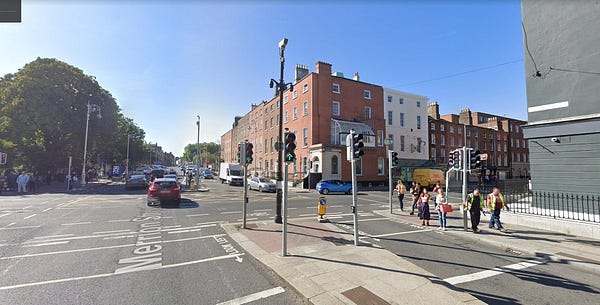Traffic lights on the internet
We're just now building them

Art: Traffic Island on Boulevard Haussmann, Gustave Caillebotte, 1880
I saw a tweet come up on my feed a couple days back celebrating the history of the first traffic light in Ireland, and I realized that I never, ever think about traffic lights, in spite of being exposed to them constantly every day.




This took me down a Wikipedia rabbit hole about how traffic lights came into being, how humans used to direct traffic for a long time, how many years it took to design the traffic lights we all know and love/hate today, and all the various traffic light designs, including how the ones in the States came to be. Of course, as you may have guessed, each state had its own idea.
Our road symbols are pretty much solidified at this point, to the point where no one pays attention to them. (Except, if you’re on my local Nextdoor and engaged in a 32-comment-deep discussion about whether a local “No Turn on Red” intersection is really a yield sign, a suggestion, and how many people have actually yielded or turned there over the years. So far, the local police chief, a budding road sign designer, and various local residents have weighed in, none coming to a definitive conclusion. It’s the most wholesome thing I’ve ever witnessed online.)
But, during the process of iterating on traffic lights and road symbols, we sure were confused. Look at American intersections before traffic lights.

It took basically at minimum 30 years from the time that traffic lights started being mainstream until they were standardized in form, and probably 50 years until they were used the same way around the world.
I was thinking about this recently as I saw that Facebook was debating a kill switch. Two, actually. One to detect the spread of viral content and stop it if it grows too quickly, and one related to the American election.
The first one seems like such a no-brainer, and it’s surprising that more social media platforms don’t exercise these kinds of switches. For example, WhatsApp had to institute similar controls recently in India to stop misinformation from spreading:
While many people use WhatsApp to communicate one-on-one, there are growing concerns about how large WhatsApp groups of friends and acquaintances are being used to share information, creating the perfect environment for forwarding political images and videos.
The BBC researchers found Indians tend to read and believe information forwarded to them by individuals they know or trust, rather than discerning between news stories based on the original source of the information.
In India — the nation where people forward more WhatsApp content than anywhere else — WhatsApp-spread fake news is inciting mob violence and literally getting people killed. On Thursday, WhatsApp announced in a blog post that it plans to make several changes in an effort to prevent more violence.
Some of the changes will only apply to users in India. They will no longer see the “quick forward” button next to photos and videos that made that content particularly easy to send along quickly, without incorporating information about where it came from. They’ll also no longer be able to forward content to more than five chats at a time. In the rest of the world, the new limit for forwards will be 20 chats. The previous cap was 250.
Just like we’re in the steam-powered days of machine learning, we’re also in the very early stages of traffic lights for the internet. Whether those come from internal pressures or legislative efforts like GDPR, or from state-sponsored actors, like happened in Belarus, it’s coming. The wild and free days of the internet are truly, for realsies, over.
It remains to be seen where we end up, but I’m hopeful that, like with traffic lights, we iterate to some form of lawful neutral.
What I’m reading lately:
How news spreads online:


The Newsletter:
This newsletter’s M.O. is takes on tech news that are rooted in humanism, nuance, context, rationality, and a little fun. It goes out once or twice a week. If you like it, forward it to friends and tell them to subscribe!
The Author:
I’m a machine learning engineer. Most of my free time is spent wrangling a kindergartner and a baby, reading, and writing bad tweets. Find out more here or follow me on Twitter.




Three cheers for Jordan Mechner's book. What an incredible look at the creative process.